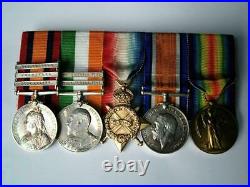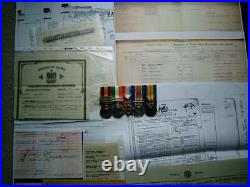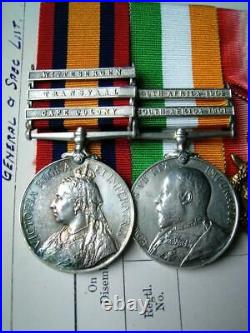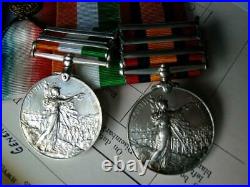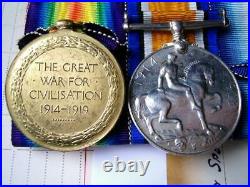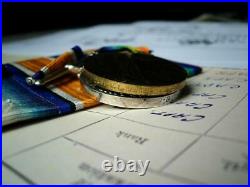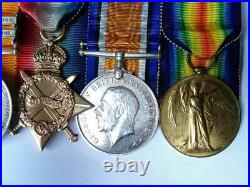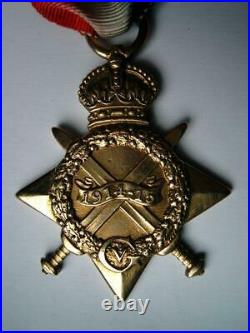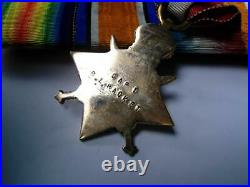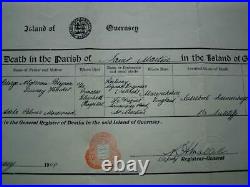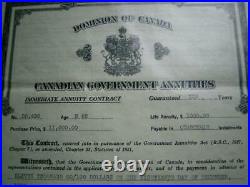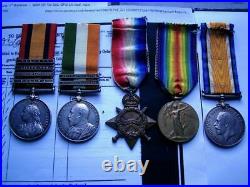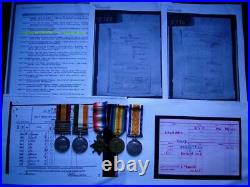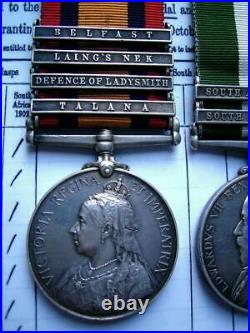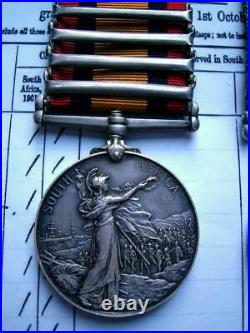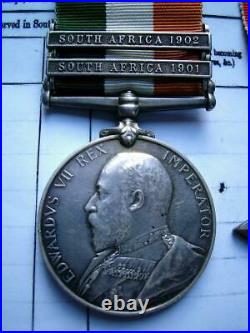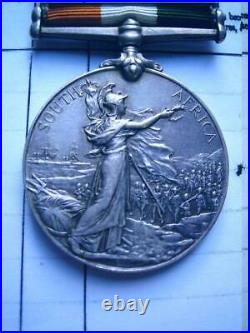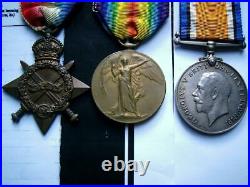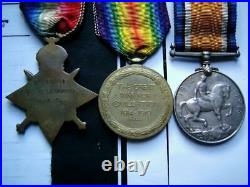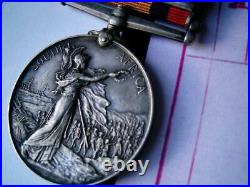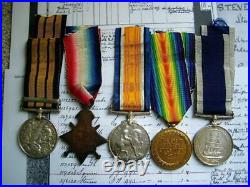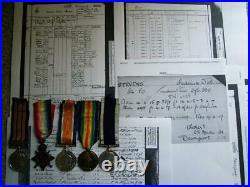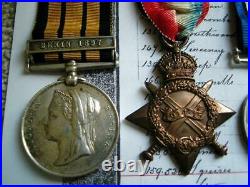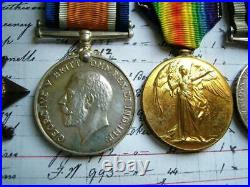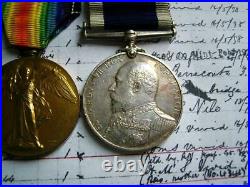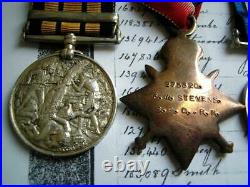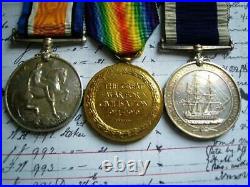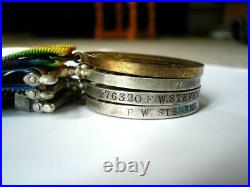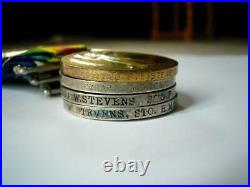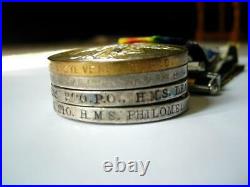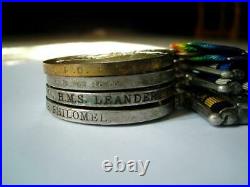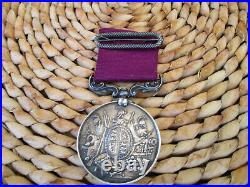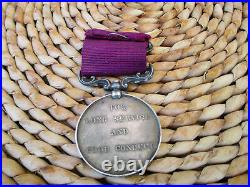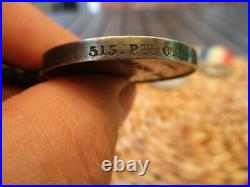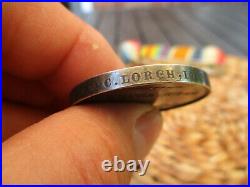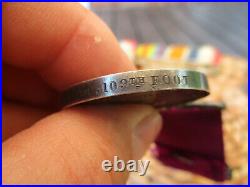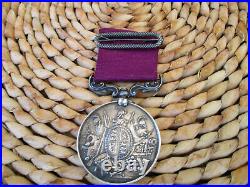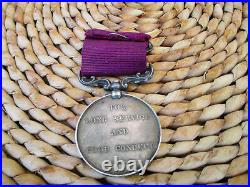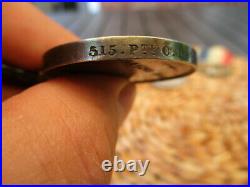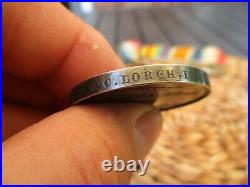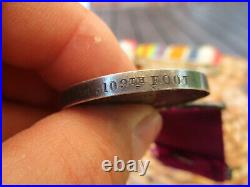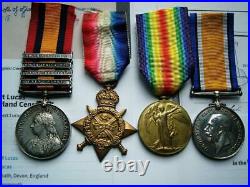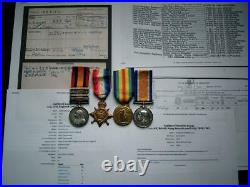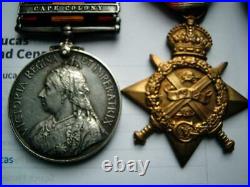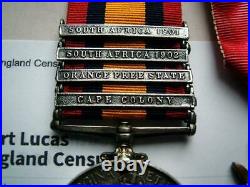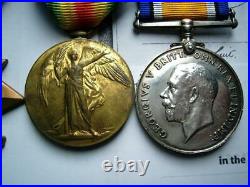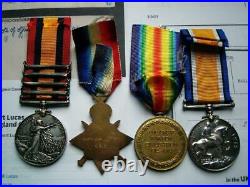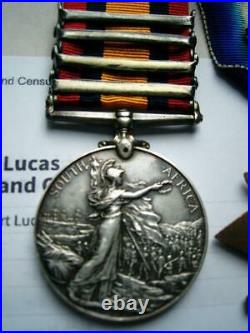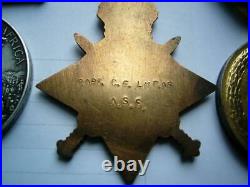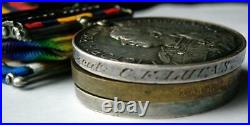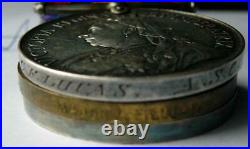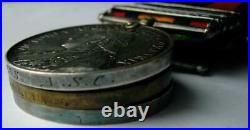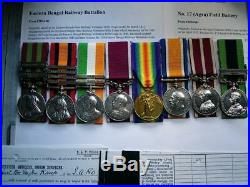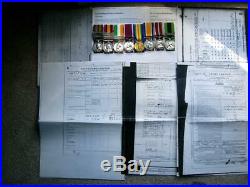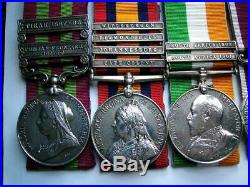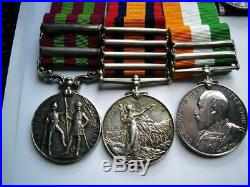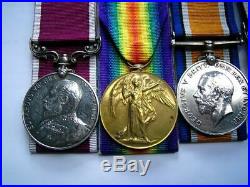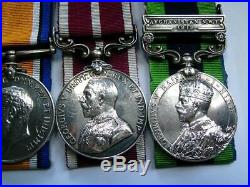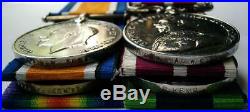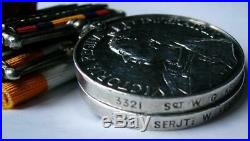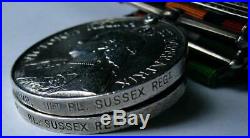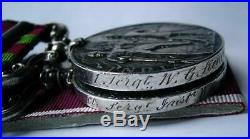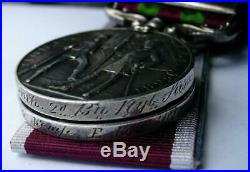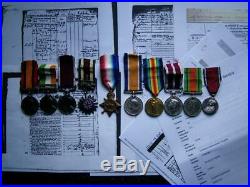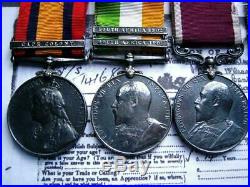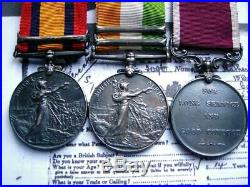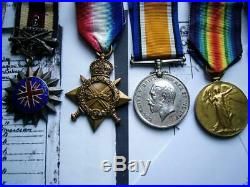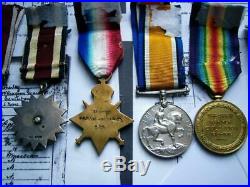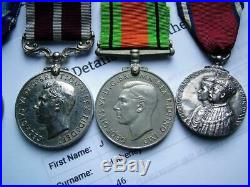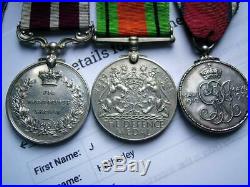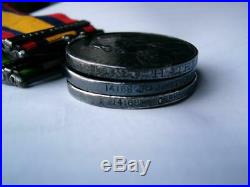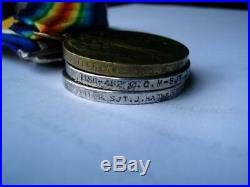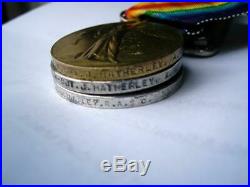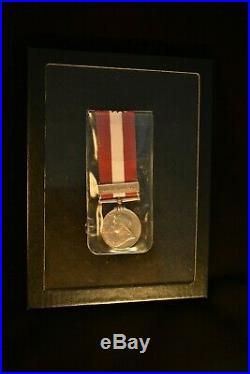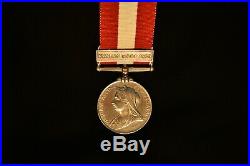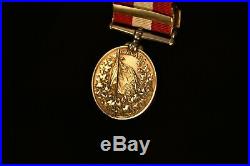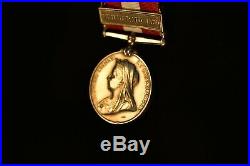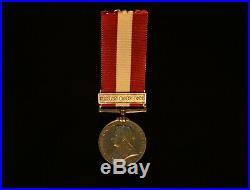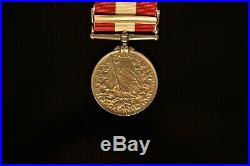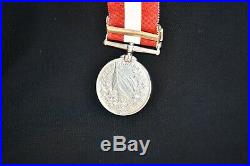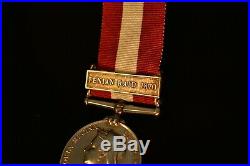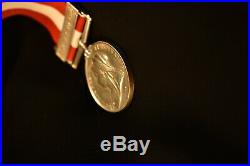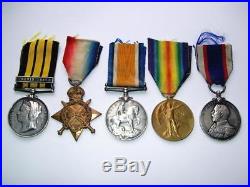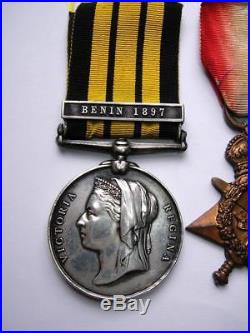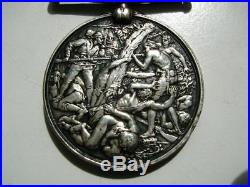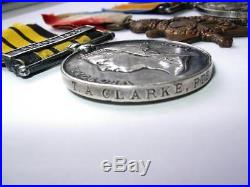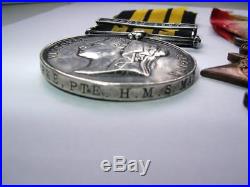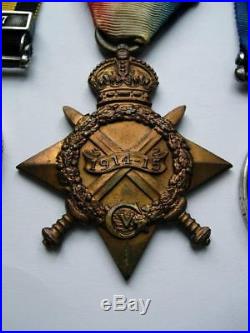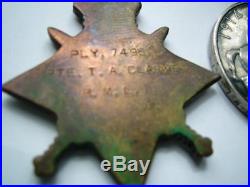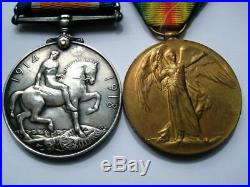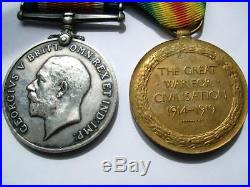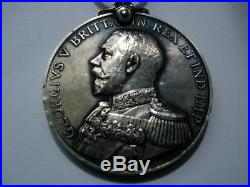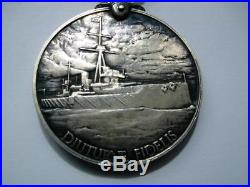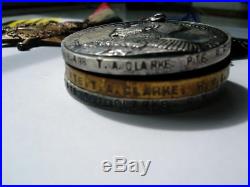- Country/Region of Manufacture: United Kingdom
- Country/ Organization: United Kingdom
- Issued/ Not-Issued: Issued
- Theme: Militaria
- Type: Medals & Ribbons
- Conflict: Boer War (1899-1902)
- Service: Army
- Era: 1816-1913
Archive for the victorian Category
Due to the string of defeats during Black Week in December 1899, the British government realized they were going to need more troops than just the regular army to fight the Second Boer War. On 13 December, the decision to allow volunteer forces serve in the field was made, and a Royal Warrant was issued on 24 December. This officially created the Imperial Yeomanry (IY). The Royal Warrant asked standing Yeomanry regiments to provide service companies of approximately 115 men each. In addition to this, many British citizens (usually mid-upper class) volunteered to join the new force. The first contingent of recruits contained 550 officers, 10,371 men with 20 battalions and 4 companies. The first company left Southampton on 31 January 1900, bound for Cape Town, and the whole first contingent arrived in South Africa between February and April. Upon arrival, the IY battalions were sent throughout the zone of operations. The Hampshire Yeomanry raised two service companies for the IY: 41st (Hampshire) Company, which arrived in South Africa on 23 February 1900 and served in 12th Battalion, IY, until 1902 when it transferred to 4th Battalion; and 50th (Hampshire) Company, which landed at Beira, Mozambique, on 4 May 1900 and served with 17th Battalion. In May and June 1900, 12th Battalion, IY, was in Lord Roberts’s army, while the 17th was in Lt-Gen Carrington’s Rhodesian Field Force. The Hampshire IY companies served until 1901, earning the regiment its first Battle honour: South Africa 190001. The Imperial Yeomanry were trained and equipped as mounted infantry. After the Boer War all Yeomanry regiments were termed Imperial Yeomanry until 1907 The battles of 1915 showed both the Allies and the Germans how difficult it was to break through on the Western Front. In most battles, the British and French had around a three-to-one superiority in men and artillery. But, although the German defenders gave ground, they did not break and were often able to retake some of their lost positions. Both side drew lessons from this, the results of which would be demonstrated in the huge attritional struggles of the following year. Victorian Major Hacket Hampshire Imperial Yeomanry QSA KSA Boer war & WW1 medal. 12th Imp: Yeo:”; Kings South Africa 1901-02, 2 clasps, South Africa 1901, South Africa 1902 , official engraved “Lt. “; 1914-15 Star unofficial re-impressed (light signs of previous erasure), British War and Victory Medals official impressed “Capt. , IMO Extremely fine, minimal wear, mounted for display. See pictures for condition Charles Lisle Hacket was born in Rugby, Warwickshire, in 1873, a descendent of the Stuart monarchs of Scotland, and attested for the Imperial Yeomanry at Newport on 8 January 1900, having previously served with the Hampshire Carabineers. He served with the 41st (Hampshire) Company, 4th Battalion, a cavalry unit of the Imperial Yeomanry in South Africa during the Boer War from 31 January 1900, and was commissioned Lieutenant on 8 May 1901, subsequently serving with the Remount Department. He saw further service during the Great War as a Captain on the General List on the Western Front from 25 October 1915, and was promoted Major on relinquishing his commission. In civilian life Hacket had business interests in both Canada and East Africa, and papers included suggest that he was suspected of being guilty of bigamy, with a wife on both continents. He died in Guernsey on 18 January 1949. Imperial Yeomanry mounted Infantry Due to the string of defeats during Black Week in December 1899, the British government realized they were going to need more troops than just the regular army to fight the Second Boer War. After the Boer War all Yeomanry regiments were termed Imperial Yeomanry until 1907 WW1 Western Front The battles of 1915 showed both the Allies and the Germans how difficult it was to break through on the Western Front. Showcase your items with Auctiva’s. Track Page Views With. Auctiva’s FREE Counter. The item “Victorian Major Hacket Hampshire Imperial Yeomanry QSA KSA Boer war & WW1 medal” is in sale since Sunday, November 14, 2021. This item is in the category “Collectables\Militaria\Boer War (1899-1902)”. The seller is “theonlineauctionsale” and is located in England. This item can be shipped worldwide.
Henry Leonard was born at Findern, Northamptonshire in 1875 the son of Thomas and Sarah Leonard. Enlisting on 13 October 1893 with the 2nd Battalion, Leicester Regiment he transferred to the 1st Battalion on 2 January 1896. Posted to South Africa with this unit on 8 January 1896 Leonard served through the Battle of Talana and the Defence of Ladysmith. The Battalion was present for the Battle of Belfast and served throughout the Guerrilla phase of the war. Leonard was transferred to the Depot on 18 August 1902 and posted back to Britain later that year on 13 September. Discharged to the Reserve he served with D Section of the Reserve Battalion from 9 October 1905-9 October 1909 when his period of engagement ended. Having found work as a Labourer he re-attested for the Army Veterinary Corps on 21 July 1915. Leaving Britain for France again on 20 March 1916 he remained there for the duration of the war being placed on furlough between 18 August-1 September 1918. Leonard was discharged on 13 May 1919. Victorian Boer War QSA KSA WW1 medal TALANA DOL LN BELFAST clasp Leicester Regt. Scarce QSA KSA BOER WAR & WW1 medal group with Talana battle clasp. Leonard, I:Leic:Regt”; King’s South Africa 1901-02, 2 clasps, South Africa 1901, South Africa 1902 “3894 Pte H. Leicester: Regt”; 1914-15 Star “Se. “; British War and Victory Medals “Se-10921 Pte. “, all officially named, early version of medal with faint “Ghost dates, IMO Good very fine condition, see pictures for condition, supplied with some service history and medal roll copies. Start of the 2ND Boer war “TALANA HILL” October 1899. The 1st Battalion Leicester Regiment was stationed at Glencoe, in the north of Natal, when the war broke out. It thus formed part of the brigade of General Penn Symons, the other battalions being the 1st King’s Royal Rifles, 1st Royal Irish Fusiliers, and 2nd Dublin Fusiliers. There were also at Glencoe the 18th Hussars and the 13th, 67th, and 69th Batteries RFA. The troops were soon set in motion. To the Leicesters and 67th Battery was assigned the duty of guarding the camp with its great quantities of stores. The general decided to attack with his other infantry and artillery. These moved away and were soon in extended order advancing to a wood, which the commander had decided to use as a breathing place. About 8.50 the infantry again advanced, and as they left the wood had to face a terrible rifle-fire both from their front and flank. Sir W Penn-Symons, who had been exposing himself with rash bravery, fell mortally wounded about 9.30; Brigadier General Yule, now in command, directed the infantry to move to a wall stretching some distance along the hillside, from which wall a very heavy fire was being kept up by the Boers. The two batteries redoubled their efforts. The 1st King’s Royal Rifles on the right first reached the wall, followed by some companies of the Irish Fusiliers; the Dublin Fusiliers also made their way up a little later. After another breathing space under cover of the wall the troops jumped the wall and scrambled up the steep face. Then followed the first blackguardly use of the white flag. Within easy range of our artillery were to be seen clumps of 50 and 100 men on which guns could have inflicted great loss. The enemy, however, displayed a white flag, although they do not appear to have had any intention of surrendering, and in consequence the officer commanding Royal Artillery refrained from firing. One can scarcely acquit this officer from being very easily taken in, as the enemy’s continued movement contradicted any idea of surrender. The infantry had done magnificently; the same cannot be said of the Hussars, or at least those under Colonel Moller, who managed to get lost among the enemy, and was taken prisoner with 200 men. The artillery did well, but it seems beyond doubt that they fired at the hill-top after it was occupied by our people, causing some loss, particularly to the King’s Royal Rifles. The range was short, and artillery officers with proper glasses should have seen when the British troops were up. The Leicesters lost 1 officer killed, 1 wounded, and 1 man wounded. Leicester regiment mounted infantry. On the 21st General Yule moved his camp to a better position. On the 22nd he resolved to retreat on Ladysmith. At nine at night in silence, without bands or pipers, the force set out by the east or Helpmakaar road, the dying general, the other wounded, and the doctors being left. A great mass of stores had also to be left to the enemy, as its destruction would have made him suspect the intended retreat; while, on the other hand, a twelve hours’ start was absolutely necessary. To have fought their way to Ladysmith would have been an impossible task for Yule’s column in that hilly country. As it was, the Boers showed that inexplicable want of energy which seemed at times in the campaign to paralyse them. Probably the good things left in Dundee had something to do with the lack of activity. Fortunate it was that General Yule was not interfered with by the enemy, but the elements were not favourable. The rain at times fell in torrents; roads knee-deep in mud and swollen spruits made marching very heavy work, while but little sleep was obtainable between the 21st and 26th. On the 30th, in the battle of Ladysmith (Defence and later relief), the Leicesters were with Colonel Grimwood on the right and had a very trying day. They had about 24 casualties. After the siege began the Leicesters occupied posts on the north side, and they were not much pressed in the great attack on 6th January 1900. For their work during the siege 2 officers and 3 men were mentioned in Sir George White’s despatch of 23rd March 1900. When the Boers retreated Spring 1900 from natal, every bridge, culvert, reservoir and railway was a target to be destroyed including Lang’s Nek tunnel. The rapid British advance of Spring 1900 prevented the Boers from damaging the tunnel to the extent they wished. They hurriedly dynamited the two entrances to the tunnel before Lord Dundonald and his troops occupied the position May 1900. British discovered the tunnel was not badly damaged and quickly cleared the rubble from the line. This allowed the trains to supply the British advance into the Orange Free State and Transvaal. Lang’s Nek tunnel blocked by explosion made by the Boers may 1900. When, Ladysmith having been relieved and its garrison recuperated, Sir Redvers Buller moved north, the Leicesters were brigaded with the 1st Liverpool, 1st Royal Inniskilling Fusiliers, and 1st King’s Royal Rifles. They were present at Bergendal (Battle of Belfast) and many other actions, but had a remarkable immunity from mishaps and heavy casualty lists. In his despatch of 10th October 1900 Lord Roberts mentions that in the operations about Badfontein on the way to Lydenburg the Leicesters and 1st King’s Royal Rifles pulled a field battery up a steep hill, which did much to assist in compelling the enemy to bolt. Seven officers and 9 non-commissioned officers and men of the battalion were mentioned in General Buller’s despatch of 9th November 1900, and 11 officers and 12 non-commissioned officers and men were mentioned by Lord Roberts in his final despatch. After marching to Lydenburg with General Buller, and taking part in his other operations north of the Delagoa line, the Leicesters remained in the Eastern Transvaal, sometimes trekking, as in General French’s operations, sometimes doing garrison duty. That their work was consistently good is proved by the fact that they got rather more than an average number of mentions in Lord Kitchener’s despatches during the war. For a long time prior to the close of the war they occupied blockhouses on the Standerton-Ermelo road. In the final despatch 4 officers and 6 non-commissioned officers were mentioned. RVC working on an injured horse WW1. During the First World War almost half the veterinary surgeons in Britain served as officers in the AVC, and the number of other ranks in the Corps grew from 934 to 41,755. Innovations included provision of Mobile Veterinary Sections, to transfer sick and wounded horses to veterinary hospitals, and camel specialists, who staffed hospital facilities in Egypt. As well as serving on the Western Front, the AVC was deployed with animals to such contrasting theatres of war as Gallipoli, Salonika, Mesopotamia and Palestine. In 1918 the Corps was given its Royal prefix in recognition of its service through the First World War. At the time the Quartermaster-General wrote. The Corps by its initiative and scientific methods has placed military veterinary organisation on a higher plane. The high standard which it has maintained at home and throughout all theatres has resulted in a reduction of animal wastage, an increased mobility of mounted units and a mitigation of animal suffering un-approached in any previous military operation. Hundreds of thousands of horses died during WW1, due to disease, injury, starvation and shelling, they became in very short supply by 1917, considered more valuable than a soldier as they were essential for logistical work, pulling large loads through difficult terrain, mud and shell holes made it almost impossible to use mechanised vehicles. Demobilisation in 1919 after the war was followed by mechanisation, and consequentially the RAVC was greatly reduced in size. Auctiva gets you noticed! Track Page Views With. Auctiva’s FREE Counter. The item “Victorian Boer War QSA KSA WW1 medal TALANA DOL LN BELFAST clasp Leicester Regt” is in sale since Saturday, December 4, 2021. This item is in the category “Collectables\Militaria\Boer War (1899-1902)”. The seller is “theonlineauctionsale” and is located in Offchurch. This item can be shipped worldwide.
- Country/Region of Manufacture: United Kingdom
- Country/ Organization: United Kingdom
- Issued/ Not-Issued: Issued
- Theme: Militaria
- Type: Medals & Ribbons
- Conflict: Boer War (1899-1902)
- Service: Army
- Era: 1816-1913
Frederick William Stevens was born in Kingstown, Dublin, on 3 November 1874, and joined the Royal Navy as a Stoker Second Class on 13 March 1894. He served in H. Philomel from 1 December 1894 to 17 March 1897, and was promoted Stoker on 1 August 1896. Advanced Stoker Petty Officer on 1 July 1906, he was awarded his Long Service and Good Conduct Medal on 5 May 1909. Start of WW1 was serving aboard HMS Bellona, a sout cruiser. Admitted to the Royal Naval Hospital at Plymouth as a dangerous lunatic on 31 March 1915, he was invalided out of the service to pension on 5 April of that year. Pension card shows he was discharged from asylum in April 1917. (supplied with medal roll extracts and service record). HMS Philomel Ashanti Benin 1897 WW1 trio LS&GC medal SPO Stevens RN from Dublin. East & West Africa CAMPAIGN MEDAL 1897 Benin, HMS Philomel. (supplied with medal roll extracts and service record) HMS Philomel – Cruiser In mid 1892 Philomel deployed to the Cape of Good Hope Station, where it would spend the, next six years. This punitive expedition resulted from several men being killed or wounded when a Government boat was fired upon in August. Captain Charles Campbell of Philomel led one detachment of seamen in an attack on the principal town, where there was no opposition but 106 guns were captured, as was the chiefs treasury. Recommissioning on station in August 1894, Philomel participated in the M wele Expedition in August 1895 and the Bombardment of Zanzibar in August the following year. The latter resulted from a prince trying to usurp the throne on the death of the Sultan. Britain, with the acquiescence of the other European embassies, supported the true heir. After 37 minutes of bombardment of the Sultans palace, the rebels left and the rightful successor was proclaimed. In January 1897 the British Consul General in Niger was attacked and the following month an expedition was mounted to Benin to arrest those responsible. Personnel from Philomel formed part of the Naval Brigade and during the attack the ships Captain and the Gunner were wounded. Plundered Ivory, Bronzes, sculptures etc Most of the plunder from the city was retained by the expedition with some 2,500 (official figures) religious artefacts, Benin visual history, mnemonics and artworks being sent to England. The British Admiralty confiscated and auctioned off the war booty to defray the costs of the Expedition. The expected revenue from the expedition was discussed already before Phillips set out on his ill-fated journey to the city of Benin in 1896. In a letter to Lord Salisbury, the British Foreign Secretary, Phillips requested approval to invade Benin and depose the Oba, adding the following footnote: I would add that I have reason to hope that sufficient ivory would be found in the King’s house to pay the expenses incurred in removing the King from his stool. European Modernist movement pictures influenced by Benin African art- including Picasso The dispersal of the Benin art to museums around the world catalysed the beginnings of a long and slow European reassessment of the value of West African art. The Benin art was copied and the style integrated into the art of many European artists and thus had a strong influence on the early formation of modernism in Europe. King of Benin The King of Benin was eventually captured by the British consul-general, Ralph Moor. He was deposed and sent to live out his days in Calabar. He died in 1914. HMS Bellona – Bodicea class scout cruiser He served at the start of WW1 with HMS Bellona was one of two Boadicea-class scout cruisers built for the Royal Navy in the first decade of the 20th century. Bellona spent the bulk of World War I with that squadron, He transferred to shore establishment Vivid II January 1915 but invalided to Insane assylum in April 1915. Pension record card shows he was discharged from hospital April 1917. Create your brand with Auctiva’s. Attention Sellers – Get Templates Image Hosting, Scheduling at Auctiva. Track Page Views With. Auctiva’s FREE Counter. The item “Victorian HMS Philomel Ashanti Benin 1897 WW1 LS&GC medal SPO Stevens RN Dublin” is in sale since Friday, July 23, 2021. This item is in the category “Collectables\Militaria\19th Century (1800-1899)\Medals/ Ribbons”. The seller is “theonlineauctionsale” and is located in England. This item can be shipped worldwide.
- Type: Medals & Ribbons
- Issued/ Not-Issued: Issued
- Conflict: East & West Africa Benin 1897
- Era: 1816-1913
- Country/ Organization: United Kingdom
- Time Period: 19th Century (1800-1899)
- Theme: Militaria
- Service: Navy
- Country/Region of Manufacture: United Kingdom
A NICE VICTORIAN LSGC MEDAL 515 pte c lorch 109th foot. FEEL FREE TO ASK ANY QUESTIONS TO ASK ANY QUESTIONS. The item “WW1 VICTORIAN BRITISH MEDAL” is in sale since Thursday, June 17, 2021. This item is in the category “Collectibles\Militaria\WW I (1914-18)\Original Period Items\Great Britain\Medals, Pins & Ribbons”. The seller is “scooopers” and is located in Manhasset, New York. This item can be shipped worldwide.
A NICE VICTORIAN LSGC MEDAL 515 pte c lorch 109th foot. FEEL FREE TO ASK ANY QUESTIONS TO ASK ANY QUESTIONS. The item “WW1 VICTORIAN BRITISH MEDAL” is in sale since Monday, June 7, 2021. This item is in the category “Collectibles\Militaria\WW I (1914-18)\Original Period Items\Great Britain\Medals, Pins & Ribbons”. The seller is “scooopers” and is located in Manhasset, New York. This item can be shipped worldwide.
Cuthbert Forrestier Lucas born Teignmouth, Devon, 1879. He is promoted prior to Captain WW1, served with British Expeditionary force from August 1914 earning 1914 Star, promoted to Major about October 1915 and served until retirement in February 1921 aged about 42. He was living in Bulls Barn, Ditching Common, Chailey, Sussex when he died in 1962 aged about 82. Victorian Major Lucas ASC QSA Boer war WW1 1914 Star Victory war medal Fr Devon. , IMO very fine condition, has replacement suspension and clasps are taylors copies. WW1 trio, 1914 Star has re-impressed name CAPT C. ” , Victory Medal has official impressed name ” MAJOR C. LUCAS and British war medal is neatly erased, WW1 trio otherwise generally very fine, see pictures for condition. Supplied with QSA medal roll extract confirming medal and clasps , copy WW1 medal index card, some promotion lists and family census details. WW1 Western Front He is promoted prior to Captain WW1, served with British Expeditionary force from August 1914 earning 1914 Star, promoted to Major about October 1915 and served until retirement in February 1921 aged about 42. Auctiva gets you noticed! Track Page Views With. Auctiva’s FREE Counter. The item “Victorian Major Lucas ASC QSA Boer war WW1 1914 Star Victory war medal Fr Devon” is in sale since Sunday, April 4, 2021. This item is in the category “Collectables\Militaria\Boer War (1899-1902)”. The seller is “theonlineauctionsale” and is located in England. This item can be shipped worldwide.
- Type: Medals & Ribbons
- Issued/ Not-Issued: Issued
- Conflict: Boer War (1899-1902)
- Era: 1816-1913
- Country/ Organization: United Kingdom
- Theme: Militaria
- Service: Army
- Country/Region of Manufacture: United Kingdom
SUSSEX REGT Very fine plus. LS & GC Edward VII official named “1st CL SERGT INSTR W G KEMP E B VOLTR RFLS” , WW1 British War & Victory medals “CAPT W KEMP”, both official named, very fine plus. Meritorious Service Medal GV, ACT SGT MAJ W G J KEMP I. L very fine plus. F 1919 bar, (North Western Frontier for Afghanistan 3rd war) officially named ” CAPTN W G J KEMP 41/ MULE CORPS”, very fine plus, group of eight, mounted on card for display. Supplied with some history, copy medal roll extracts and records. Victorian India QSA KSA LSGC MSM WW1 Afghan medal Captain Kemp Sussex Rgt + S&T. William George John Kemp was born in Ticehurst, Sussex, on 26 March 1871 and attested for the Royal Sussex Regiment at Chichester on 14 November 1889, having previously served in the Regiments 3rd (Militia) Battalion. Posted to the 1st Battalion, he was advanced Lance Sergeant on 19 November 1894, before transferring to the 2nd Battalion, for service in India, on 14 February 1896. He served in India from that date, and was promoted Sergeant on 4 April 1896, subsequently seeing active service on the Punjab Frontier during the Tirah campaign. Returning home on 7 October 1898, Kemp reverted to the 1st Battalion on that date, and served with them in Malta and then in South Africa during the Boer War from 19 February 1900 to 16 October 1902. He was promoted Colour Sergeant on 20 September 1902, before transferring to the Unattached List for employment as 2nd Class Sergeant Instructor of the Agra Volunteer Rifles. Kemp was awarded his Long Service and Good Conduct Medal on 14 November 1907, whilst serving as 1st Class Sergeant Instructor of the Eastern Bengal Volunteer Rifles, and was discharged in the rank of Acting Sergeant Major on 27 April 1912, after 22 years and 166 days service. Following the outbreak of the Great War Kemp was commissioned Second Lieutenant in the Indian Army Reserve of Officers on 18 October 1916, and served during the Great War as Commandant of the 27th Mule Corps, Supply and Transport Corps, Indian Army from 6 January to 21 November 1917, and then as Commandant of the 41st Mule Corps from 22 November 1917. Advanced Acting Captain on 1 October 1918, he saw active service on the North West Frontier during the Third Afghan War, before being released from Military Services on 2 May 1921. INDIA PUNJAB & TIRAH 1897-98. Rebellion Punjab Frontier 1897-98. The Afridi tribe had received a subsidy from the government of British India for the safeguarding of the Khyber Pass for sixteen years; in addition to which the government had maintained for this purpose a local regiment entirely composed of Afridis, who were stationed in the pass. Suddenly, however, the tribesmen rose, captured all the posts in the Khyber held by their own countrymen, and attacked the forts on the Samana Range near the city of Peshawar. The Battle of Saragarhi occurred at this stage. It was estimated that the Afridis and Orakzais could, if united, bring from 40,000 to 50,000 men into the field. The preparations for the expedition occupied some time, and meanwhile British authorities first dealt with the Mohmand rising northwest of the Khyber Pass. The general commanding was General Sir William Lockhart commanding the Punjab Army Corps; he had under him 34,882 men, British and Indian, in addition to 20,000 followers. The frontier post of Kohat was selected as the base of the campaign, and it was decided to advance along a single line. On 18 October, the operations commenced, fighting ensuing immediately. The Dargai heights, which commanded the line of advance, were captured without difficulty, but abandoned owing to the want of water. On 20 October the same positions were stormed, with a loss of 199 of the British force killed and wounded. The progress of the expedition, along a difficult track through the mountains, was obstinately contested on 29 October at the Sampagha Pass leading to the Mastura valley, and on 31 October at the Arhanga Pass from the Mastura to the Tirah valley. The force, in detached brigades, now traversed the Tirah district in all directions, and destroyed the walled and fortified hamlets of the Afridis. The two divisions available for this duty numbered about 20,000 men. A force about 3,200 strong commanded by Brigadier-General (afterwards Major General Sir Richard) Westmacott was first employed to attack Saran Sar, which was easily carried, but during the retirement the troops were hard pressed and had 64 casualties. On 11 November, Saran Sar was again attacked by the brigade of Brigadier-General (afterwards Sir Alfred) Gaselee. Experience enabled better dispositions to be made, and the casualties were only three. The traversing of the valley continued, and on 13 November a third brigade under Brigadier General Francis James Kempster visited the Waran valley via the Tseri Kandao Pass. Little difficulty was experienced during the advance, and several villages were destroyed; but on 16 November, during the return march, the rearguard was hotly engaged all day, and had to be relieved by fresh troops next morning. British casualties numbered 72. On 21 November, a brigade under Brigadier-General Westmacott was detached to visit the Rajgul valley. The road was exceedingly difficult and steady opposition was encountered. The objectives were accomplished, but with 23 casualties during the retirement alone. The last task undertaken was the punishment of the Chamkannis, Mamuzais, and Massozais. This was carried out by Brigadier-General Gaselee, who joined hands with the Kurram movable column ordered up for the purpose. The Mamuzais and Massozais submitted immediately, but the Chamkannis offered resistance on 1 and 2 December, with about 30 British casualties. 1899 to return via the Mastura valley, destroying the forts on the way, and to join at Bara, within easy march of Peshawar; the second division under Major General Yeatman Biggs d. 1898, and, accompanied by Lockhart, to move along the Bara valley. The base was thus to be transferred from Kohat to Peshawar. The return march began on 9 December. The cold was intense, 21 degrees of frost being registered before leaving Tirah. The movement of the first division though arduous was practically unopposed, but the 40 miles to be covered by the second division were contested almost throughout. The march down the Bara valley (34 miles) commenced on 10 December, and involved four days of the hardest fighting and marching of the campaign. The road crossed and recrossed the icy stream, while snow, sleet and rain fell constantly. On the 10th, the casualties numbered about twenty. On the 11th, some fifty or sixty casualties were recorded among the troops, but many followers were killed or died of exposure, and quantities of stores were lost. On the 12th, the column halted for rest. On the 13th, the march was resumed in improved weather, though the cold was still severe. The rearguard was heavily engaged, and the casualties numbered about sixty. On the 14th, after further fighting, a junction with the Peshawar column was effected. The first division, aided by the Peshawar column, now took possession of the Khyber forts without opposition. Negotiations for peace were then begun with the Afridis, who under the threat of another expedition into Tirah in the spring at length agreed to pay the fines and to surrender the rifles demanded. The expeditionary force was broken up on 4 April 1898. A memorable feature of this campaign was the presence in the fighting line of the Imperial Service native troops under their own officers, while several of the best known of the Indian princes served on Lockhart’s staff. Fourteen thousand British soldiers squared up against four thousand Boers and forced them from their positions on the hill. The British cavalry were under the command of Sir Ian Hamilton. He despatched Robert Broadwood’s 2nd Cavalry brigade, which included the 10th Royal Hussars, 12th Royal Lancers and the Household Cavalry Regiment, on a Special Mission. As the sun came up it was a bitterly cold Monday morning… We are hidden in the hills at Donkerhoek… Confided Botha to his diary. As a detachment of 10th Hussars swung off to the right, they were attacked from Diamond Hill. A section of Q Battery RHA attempted to return artillery fire, but had no infantry support, until the 12th Lancers arrived on the front line. The Boers pressed the matter hard. Two squadrons of Household Cavalry Regiment and one squadron of the 12th Hussars charged at full gallop at Boers firing from concealed positions. On 13th the Botha’s army retreated to the north, they were chased as far as Elands River Station, only 25 miles from Pretoria, by Mounted Infantry and De Lisle’s Australians. Forty-four years after the battle, British General Ian Hamilton opined in his memoirs that “the battle, which ensured that the Boers could not recapture Pretoria, was the turning point of the war”. Hamilton credited Winston Churchill with recognizing that the key to victory would be in storming the summit, and risking his life to signal Hamilton. A clasp inscribed “Johannesburg” will be granted to all troops who, on May 29. 1900, were north of an east and west line through Klip River Station (exclusive), and east of a north and south line through Krugersdorp Station (inclusive). Rapid growth, Jameson Raid and the Second Boer War , Johannesburg. As the value of control of the land increased, tensions developed between the Boer. Government in Pretoria and the British, culminating in the Jameson Raid. That ended in fiasco at Doornkop. In January 1896 and the Second Boer War. (18991902) that saw British forces under Field Marshal Frederick Sleigh Roberts, 1st Earl Roberts, occupy the city on 30 May 1900 after a series of battles to the south-west of its then-limits, near present-day Krugersdorp. Fighting took place at the Gatsrand Pass (near Zakariyya Park) on 27 May, north of Vanwyksrust today’s Nancefield, Eldorado Park and Naturena the next day, culminating in a mass infantry attack on what is now the waterworks ridge in Chiawelo and Senaoane on 29 May. During the war, many African mineworkers left Johannesburg creating a labour shortage, which the mines ameliorated by bringing in labourers from China, especially southern China. After the war, they were replaced by black workers, but many Chinese stayed on, creating Johannesburg’s Chinese community, which during the apartheid era, was not legally classified as “Asian”, but as “Coloured”. The population in 1904 was 155,642, of whom 83,363 were whites. A clasp inscribed “Wittebergen” will be granted to all troops who were inside a line drawn from Harrismith to Bethlehem, thence to Senekal and Clocolan, along the Basuto border, and back to Harrismith, between July 1st and 29th, 1900, both dates inclusive. Cape Colony (State Clasp). A clasp inscribed “Cape Colony” will be granted to all troops in Cape Colony at any time between October 11th, 1899, and a date to be hereafter fixed, who received no clasp for an action already specified in the Cape Colony nor Natal clasps. Fighting in India WW1. Before World War I, the Indian Army was deployed maintaining internal security and defending the North West Frontier against incursions from Afghanistan. These tasks did not end with the declaration of war. The divisions deployed along the frontier were the existing 1st (Peshawar) Division, the 2nd (Rawalpindi) Division, the 4th (Quetta) Division. The only war-formed division to serve in India was the 16th Indian Division formed in 1916, it was also stationed on the North West Frontier. All these divisions were still in place and took part in the Third Afghan War at the end of World War I. In supporting the war effort, India was left vulnerable to hostile action from Afghanistan. A Turco-German mission arrived in Kabul in October 1915, with obvious strategic purpose. Habibullah Khan abided by his treaty obligations and maintained Afghanistan’s neutrality, in the face of internal opposition from factions keen to side with the Ottoman Sultan. Despite this, localised actions along the frontier still took place and included Operations in the Tochi (191415), Operations against the Mohmands, Bunerwals and Swatis (1915), Kalat Operations (191516), Mohmand Blockade (191617), Operations against the Mahsuds (1917) and Operations against the Marri and Khetran tribes (1918). On the North East Frontier between India and Burma punitive actions were carried out against the Kachins tribes between December 1914 February 1915, by the Burma Military Police supported by the 1/7th Gurkha Rifles and the 64th Pioneers. [28] Between November 1917 March 1919, operations were carried out against the Kuki tribes by auxiliary units of the Assam Rifles and the Burma Military Police (BMP). The other divisions remaining in India at first on internal security and then as training divisions were the 5th (Mhow) Division, the 8th (Lucknow) Division and the 9th (Secunderabad) Division. Over the course of the war these divisions lost brigades to other formations on active service; The 5th (Mhow) Division lost the 5th (Mhow) Cavalry Brigade to the 2nd Indian Cavalry Division. The 8th (Lucknow) Division lost the 8th (Lucknow) Cavalry Brigade to the 1st Indian Cavalry Division and the 22nd (Lucknow) Brigade to the 11th Indian Division. The 9th (Secunderabad) Division lost the 9th (Secunderabad) Cavalry Brigade to the 2nd Indian Cavalry Division and the 27th (Bangalore) Brigade which was sent to British East Africa. 3rd Anglo-Afghan war NWF India 1919. British Field Artillery pieces North West Frontier – Afghanistan/India The Third Anglo-Afghan War of 1919 was the War for Afghanistan Independence, began on 6 May 1919 when the Emirate of Afghanistan invaded British India and ended with an armistice on 8 August 1919. The war resulted in the Afghans winning back control of foreign affairs from Britain, and the British recognizing Afghanistan as an independent nation. It was also a minor strategic victory for the British because the Durand Line was reaffirmed as the border between Afghanistan and the British Raj, and the Afghans agreed not to foment trouble on the British side. Although, Afghans who were on the British side of the border did cause concerns due to revolts for many years to come. While ostensibly the country remained independent, under the Treaty of Gandumak (1879) it accepted that in external matters it would… Have no windows looking on the outside world, except towards India. Indian Army troops NW Frontier Afghanistan The death in 1901 of Emir Abdur Rahman Khan led indirectly to the war that began 18 years later. His successor, Habibullah, was a pragmatic leader who sided with Britain or Russia, depending on Afghan interests. Despite considerable resentment over not being consulted over the Anglo-Russian Convention of 1907 Convention of St. Petersburg, Afghanistan remained neutral during the First World War (191418), resisting considerable pressure from the Ottoman Empire when it entered the conflict on the side of Imperial Germany and the Sultan (as titular leader of Islam) called for a holy war against the Allies. Despite remaining neutral in the conflict, Habibullah did in fact accept a Turkish-German mission in Kabul and military assistance from the Central Powers as he attempted to play both sides of the conflict for the best deal. Through continual prevarication, he resisted numerous requests for assistance from the Central Powers, but failed to keep in check troublesome tribal leaders, intent on undermining British rule in India, as Turkish agents attempted to foment trouble along the frontier. The departure of a large part of the British Indian Army to fight overseas and news of British defeats at the hands of the Turks aided Turkish agents in efforts at sedition, and in 1915 there was unrest amongst the Mohmands and then the Mahsuds. Not withstanding these outbreaks, the frontier generally remained settled at a time when Britain could ill afford trouble. NW Frontier 1919 After the suspicious death of Habibullah the ruler of Afghanistan early 1919, Amanullah his son upon seizing the throne in April 1919, posed as a man of democratic ideals, promising reforms in the system of government. He stated that there should be no forced labour, tyranny or oppression, and that Afghanistan should be free and independent and no longer bound by the Treaty of Gandumak of 1879 (Peace treaty with the British). Amanullah had his uncle Nasrullah arrested for Habibullah’s murder and had him sentenced to life imprisonment. Nasrullah had been the leader of a more conservative element in Afghanistan and his treatment rendered Amanullah’s position as Amir somewhat tenuous. By April 1919 he realised that if he could not find a way to placate the conservatives, he would be unlikely to maintain his hold on power. Looking for a diversion from the internal strife in the Afghan court and sensing advantage in the rising civil unrest in India following the Amritsar massacre, Amanullah decided to invade British India. RAF Afghanistan 1919 Casualties during the conflict amounted to approximately 1,000 Afghans killed in action, while the British and Indian forces lost 236 killed in action. In addition, 615 were wounded, 566 died from cholera, and 334 died as a result of other diseases and accidents. Regardless of casualties, the outcome of the Third Anglo-Afghan War remains contentious. Ostensibly, the result of the conflict was a British tactical victory. This is by virtue of the fact that the British repulsed the Afghan invasion and drove them from Indian territory, while Afghan cities were subjected to attack by Royal Air Force bombers. Nevertheless, the Afghans were ultimately able to secure their strategic political goals in the aftermath of the conflict. Thus the extent of the British tactical victory was limited, and the Afghans also made strategic gains. Tailor your auctions with Auctiva’s. Track Page Views With. Auctiva’s FREE Counter. The item “Victorian India QSA KSA LSGC MSM WW1 Afghan medal Captain Kemp Sussex Rgt + S&T” is in sale since Monday, June 1, 2020. This item is in the category “Collectables\Militaria\Boer War (1899-1902)”. The seller is “theonlineauctionsale” and is located in Offchurch. This item can be shipped worldwide.
- Country/Region of Manufacture: United Kingdom
- Country/ Organization: Great Britain
- Issued/ Not-Issued: Issued
- Type: Medals & Ribbons
- Conflict: India, Boer War, World War I, 3rd Afghan War
- Service: Army
- Era: 1816-1913
Re-engraved name, claw repinned ; King’s South Africa 1901-02, 2 clasps, South Africa 1901, South Africa 1902 14168 Corpl: J. Official impressed; 1914-15 Star T1SR-482 C. ; British War and Victory Medals T1SR-462 C. ; Army Meritorious Service Medal, G. ; Coronation 1935; Impressed official named, Corps of Commissionaire Medal (hallmarked silver Birmingham 1905), silver, unnamed as issued, WW2 Defence unnamed as issued. Some wear to naming, contact marks and wear to high spots dark patina pre WW1, good fine / very fine, WW1 medals traces of lacquer, Good very fine/extremely fine, see pictures for condition. Supplied with a large amount of copied history. Victorian QSA KSA WW1 MSM WW2 medal group Sgt Hatherley Dragoon Guards late ASC. Some wear to naming, contact marks and wear to high spots on pre WW1 medals, good fine / very fine, WW1 medals traces of lacquer, Good very fine/extremely fine, see pictures for condition. Supplied with a large amount of copied history of this boy soldier, for further research James Hatherely, Born Kensington London abt 1871, Attested about 1886 for the 1st Dragoon Guards at Canterbury, trade “Musician” aged just 14 years 10 months as “Boy”, promoted Private Hatherley when 18 years old. He was posted to India with the Dragoon Guards in 1887-91 almost 4 years. He married his wife Emma in 1903 in Farnham, Surrey, while serving in the army and they had several children. He was awarded Long Service good conduct medal July 1907, completed almost 25 years in army when discharged end of service October 1910. The Corps of Commissionaires medal is awarded for long and exemplary service in the Corps, so he must have worked as a Commissionaire, (security job). The Corps of Commissionaires was established in February 1859 by Captain Sir Edward Walter with the aim of providing employment for ex-servicemen returning home from duty. Since 1901, the reigning sovereign is Chief Life Governor. He re-enlisted WW1 aged 42 for the ASC, rank Corporal 8th Sept 1914, quickly promoted to Sergeant 18th Sept and by 1915 was promoted Quartermaster Sergeant, involved in Horse Transport and supply, 42nd Division train, No428 Horse Transport Company. In May 1917 he was taken ill with suspected appendicitis while Company Quartermaster Sergeant. He was demobilised just after end of war to Z Reserve March 1919, having served about 30 years in the regular army. The MSM, Meritorious Service Medal, is a silver medal for distinguished service, devotion to duty, or for gallantry, principally by non-commissioned officers of all of the British armed forces and of Queen Alexandra’s Royal Naval Nursing Service. The Defence Medal is a campaign medal instituted by the United Kingdom in May 1945, to be awarded to subjects of the British Commonwealth for both non-operational military and certain types of civilian war service during the Second World War. Interesting medal group, history of a man who served his country well for many years. Some copy medal roll extracts, part military history and reference from commanding officer included, for further research. During the Boer war Lord Roberts points out the difficulty of getting up supplies by trains, and says, “Again the supply of the army after leaving Bloemfontein was a matter of very grave anxiety, and it was only by the devotion and zeal of the Army Service Corps officers that the supplies were brought from the rail-head to the troops in sufficient time to supply their daily wants”. After mentioning the fact that until September 1900 the army was dependent on 95 old engines, while the Orange River Colony and Transvaal found in peacetime 250 engines were necessary for their daily use, Lord Roberts says: In the above I have only referred to the work done in supplying the troops based on the Cape Colony. The Natal Army has reason also to be entirely satisfied with the manner in which it has been supplied, and the occasions have been rare when any portion of this army have had anything but full rations. These services reflect the greatest credit on Colonel W Richardson, CB, and Colonel E W D Ward, CB, directors of supplies, and the Army Service Corps serving under them. Tommies going over the top WW1. In the Great War, the vast majority of the supply, maintaining a vast army on many fronts, was supplied from Britain. Using horsed and motor vehicles, railways and waterways, the ASC performed prodigious feats of logistics and were one of the great strengths of organisation by which the war was won. RASC Trucks WW1 1914-18. Motor transport was still very new and only just becomming a more reliable means of transport. Unfortunately many roads were often too difficult to get a 2 wheel drive vehicle through the muddy, boggy, uneven and steep terrain. The ASC, Army and Royal Artillery were heavily reliant on trains, waterways and horses for transport of supplies and men to the front. WW1 War horses working hard Between 1914 and 1918 Britains war effort was dependent on its horses. At the start of the war, horse power was still a key method of moving the army and its supplies to destinations across Europe. The volume of military stores and rations required at the front was much greater than it had been in earlier conflicts. Even though the importance of the cavalry was in decline and motorised transport was becoming more reliable, trench warfare meant that provisions had to be brought in from a distance and very often over ground that wasnt suitable for other means of transport. There was an urgent demand for large numbers of draught- and packhorses, mules and other animals. Prior to the First World War the British army possessed around 25,000 horses; by the middle of 1917 this had increased to around 600,000, plus camels and oxen. The role of the Royal Army Service Corps in the field falls into two main parts, supply and transport. Supply embraces the provision of food, petrol and lubricants, fuel and light, hospital supplies and disinfectants. Transport is concerned with the conveyance of the above supplies, together with ammunition, engineer stores, ordnance stores and post, from railhead, or from base if no railhead exists, to all units of a field force. In addition RASC units are provided for the carriage of infantry, tanks and heavy bridging equipment. The mechanical transport of medical and certain other units is also found and operated by the RASC. To enable these services to be undertaken effectively, the RASC are responsible for the provision, repair, and maintenance of their own mechanical transport. General Transport Companies are allotted to divisions for the transport of ammunition, supplies and petrol. Similar companies are allotted to higher formations and for employment in Line of Communication areas as required. Personnel of the RASC are trained to fight as infantry and RASC units are responsible for their own local defence. DIVISIONAL RASC The role of the RASC companies was to keep the front line units supplied. In order to do this there were three different operations which were carried on simultaneously. By the end of the campaign it was usual to have a company assigned to supplies, another to petrol and a third to ammunition. Early in the campaign it was more usual to have companies serving brigades and have those companies each assign a platoon to supplies, petrol and ammunition. Cleary the brigade company allowed the brigade to operate independently and was well suited to the rapid advances of armoured divisions. The Home Guard in 1940 were an armed uniformed civilian militia, entirely distinct from the regular armed forces. Volunteers originally had no recognised military rank, were not subject to military discipline and could withdraw (or be withdrawn by their employers) at any time. In 1941, nominal ranks were introduced for Home Guard’officers’, and in 1942, limited conscription was implemented intended for circumstances where Home Guard forces were taking over functions from regular forces (chiefly coastal artillery and anti-aircraft batteries), and non-officer volunteers became’privates’. Volunteers remained legally civilians and failure to attend when ordered to do so was punishable by civilian authorities. Nevertheless, the British Government consistently maintained that as Home Guard service was strictly to be undertaken only in approved uniform. Recruits were underaged, not A1 fit or too old for for regular army service (Regular army age 18-41 during WW2) upper age limit for Home Guard service was 65 but not strictly enforced. The Home Guard had a number of secret roles. That included sabotage units who would disable factories and petrol installations following the invasion. Members with outdoor survival skills and experience (especially as gamekeepers or poachers) could be recruited into the Auxiliary Units, an extremely secretive force of more highly trained guerrilla units with the task of hiding behind enemy lines after an invasion, emerging to attack and destroy supply dumps, disabling tanks and trucks, assassinating collaborators, and killing sentries and senior German officers with sniper rifles. They would operate from pre-prepared secret underground bases, excavated at night with no official records, in woods, in caves, or otherwise concealed in all sorts of interesting ways. It is a common fallacy that the Home Guard never fired a shot in anger during the whole of the Second World War. In fact, individual Home Guardsmen helped man anti-aircraft guns as far early as the Battle of Britain during the summer of 1940. By 1943, the Home Guard operated its own dedicated batteries of anti-aircraft guns, rockets, coastal defence artillery and engaging German planes with their machine guns. They are credited with shooting down numerous Luftwaffe aircraft and the V-1 flying bombs that followed them in the summer of 1944. The Home Guard’s first official kill was shot down on Tyneside in 1943. The Home Guard in Northern Ireland also took part in gun battles with the IRA. A major new function emerged for the Home Guard after the German bombing campaign, the Blitz, in 1940 and 1941; resulting in large numbers of unexploded bombs in urban areas. Home Guard units took on the task of locating unexploded bombs after raids and, if such bombs were found (often after several months or years), would commonly assist in sealing off the danger area and evacuating civilians. Most Home Guard wartime fatalities occurred in the course of that task. Aside from deaths in accidents, the Home Guard lost a total of 1,206 members on duty to unexploded bombs, air and rocket attacks during the war. I will use 1st class recorded on lower value items but please be patient if your item is delayed, the post is very safe and items are tracked, thanks for understanding. China, Russian Federation, Australia and New Zealand particularly bad at the moment due to countries closing boarders, restricting flights, social distancing measures etc. These rules may be relaxed, May, June, July in stages and post will start moving again. Thanks for your patience and understanding during these strange times, stay safe and well. Tailor your auctions with Auctiva’s. Track Page Views With. Auctiva’s FREE Counter. The item “Victorian QSA KSA WW1 MSM WW2 medal group Sgt Hatherley Dragoon Guards late ASC” is in sale since Saturday, May 9, 2020. This item is in the category “Collectables\Militaria\World War I (1914-1918)\Other World War I Militaria”. The seller is “theonlineauctionsale” and is located in Offchurch. This item can be shipped worldwide.
- Country/Region of Manufacture: United Kingdom
- Country/ Organization: Great Britain
- Issued/ Not-Issued: Issued
- Type: Medals & Ribbons
- Conflict: Boer War (1899-1902)
- Service: Army
- Era: 1816-1913
This medal was awarded to members of the Imperial and Canadian forces who, between 1866 and 1870, took part in the suppression of raids by the Fenian Brotherhood, and Irish Republican organization based in the US, and Riel’s First Rebellion of 1870, the latter being generally referred to as the red River Expedition. These unsuccessful raids, conducted on British outposts in Canada, were attempts to pressure Britain to abandon it’s battle with Ireland. The piece is beautiful. With a lovely silver patina, the piece has a swivel feature at the top of the medal, to be able to spin it 360 degrees, to show whichever side you’d like. The original ribbon is in excellent condition, as is the medal itself, as this piece has been kept in a sleeve and case for the last 50-some-odd years (my grandfather’s time owning it). As always, any questions or queries will be promptly addressed and any requests will be taken care of by day’s end. We’re always happy to just chat about history! The item “Victorian Fenian Raid Medal Pre-WW1 Original Not Named” is in sale since Wednesday, August 7, 2019. This item is in the category “Collectibles\Militaria\WW I (1914-18)\Original Period Items\Canada”. The seller is “daniegerma2″ and is located in Toronto, Ontario. This item can be shipped worldwide.
- Modified Item: No
Victorian & WW1 medals East West Africa Benin 1897 LSGC T Clarke Royal Marines. East & West Africa CAMPAIGN MEDAL Benin 1897 named Private Thomas A Clarke Royal Marines H. One of 80 East & West Africa M. Benin Expedition of 1897. Was a punative expedition. By a United Kingdom force of 1,200 under Admiral Sir Harry Rawson. In response to the ambush of a previous British-led party under Acting Consul General James Philips (which had left all but two men dead). Rawson’s troops captured, burned, and looted Benin City. Bringing to an end the west African Kingdom of Benin. As a result, much of the country’s art, including the Benin Bronzes, were relocated to Britain. Private T A Clarke Royal Marines Light Infantry served aboard HMS Magpie, he would have been one of the 1200 men involved in the punative action against Benin kingdom 1897. In February 1897, HMS “Magpie” was part of a squadron that landed a Naval Brigade in what is now Dahomey where the “city” of Benin was captured and destroyed. Royal Marine Clarke was one of only 80 on HMS Magpie awarded the medal with Benin 1897 Clasp. Was a 6-gun, “Readbreast class” composite screw gunboat. Built at Pembroke Dock, launched 15-Mar-1889, 165ft long, 31ft wide and displacing 805 tons. Armed with 6 x 4in guns. During this expedition HMS Magpie was commanded by Henry Venn Wood Elliot. He was promoted to the rank of Commander dated 25 May, 1897, for his services in the Benin Expedition. GREAT WAR 1914-18 Battleship HMS Majestic. Private Clark enrolled in the Royal Navy Fleet reserve 1904 and was recalled at outbreak of war 1914, serving on the battleship HMS Majestic. In early 1915, she was dispatched to the Mediterranean. For service in the Dardanelles Campaign. She participated in bombardments of Turkish. Forts and supported the Allied landings at Gallipoli. During the campaign 18th April 1915 she was involved in a Victoria Cross action, the rescue of British Submarine E-15. Sadly on 27 May 1915, she was torpedoed by a German U-Boat. U-21 at Cape Helles. Sinking with the loss of 49 men, he survived the sinking. He served next on two more battleships, HMS Revenge and later HMS Redoubtable, invalided out of service April 1918 and received the Great War trio, (1914-15 Star, British War and Victory medal) and later the Royal Navy Reserve Long Service Good Conduct medal March 1923. Copy service record included. Auctiva gets you noticed! Attention Sellers – Get Templates Image Hosting, Scheduling at Auctiva. Track Page Views With. Auctiva’s FREE Counter. The item “Victorian & WW1 medals East West Africa Benin 1897 LSGC T Clarke Royal Marines” is in sale since Thursday, May 03, 2018. This item is in the category “Collectables\Militaria\19th Century (1800-1899)\Medals/ Ribbons”. The seller is “theonlineauctionsale” and is located in England. This item can be shipped worldwide.
- Type: Medals & Ribbons
- Era: 1816-1913
- Issued/ Not-Issued: Issued
- Conflict: Africa 1897 – WW1 1914-18
- Service: Marines
- Country/ Organization: Great Britain
- Country/Region of Manufacture: United Kingdom
